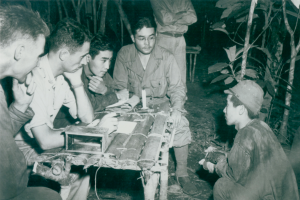History of Military Intelligence Service (MIS)

By 1941, as conflict with Japan was becoming more likely, the U.S. Army began recruiting soldiers proficient in Japanese. With a small budget and an abandoned hanger at Crissy Field in the Presidio of San Francisco, about 60 students most of whom were Japanese Americans, started the first class on November 1, 1941. Ironically, the Presidio of San Francisco was also the headquarters of Lieutenant General John DeWitt, who established military zones from which to exclude persons of Japanese decent and to spearhead internment actions. During the mass evacuation from the Pacific Coast in the spring of 1942, the language school was moved to Camp Savage, Minnesota. It was renamed the Military Intelligence Service Language School (MISLS).
The graduates of the school became the “eyes and ears” of the Allied forces in the Pacific. Usually assigned in teams to a wide range of units, they translated captured documents and messages, interrogated prisoners, broadcast propaganda, encouraged Japanese soldiers and civilians to surrender, worked on various aspects of the War Crimes trials, and played an important role generally in the postwar occupation. MISLS graduates were at Guadalcanal, with Merrill’s Marauders in Burma, Corregidor, Mindanao, the Solomons, the Marianas, Kwajalein, Leyte, New Guinea, Luzon, Iwo Jima, Okinawa, and numerous other major battles.
Ironically, it was the often-mistrusted Kibei (born in the US, educated in Japan) who proved to be the most skilled translators and interrogators. By August 1944, the school had trained some 1800 soldiers and was moved to a larger and better-equipped facility at nearby Fort Snelling, Minnesota. Ultimately, over 3,000 soldiers served with the MIS during the war and 3,000 more during occupation of Japan helping General MacArthur to democratize Japan and not allowing the Soviet Union to co-occupy Japan.
The school was closed in 1946 in preparation for its move to the Presidio of Monterey where it became the current Defense Language Institute. Fittingly, several of its buildings, such as Hachiya Hall (killed in action in the Philippines in 1945), are named after Nisei soldiers. Unfortunately, until the secrecy prohibitions were lifted in the 1970s, the contributions of the MIS were not publicized and thus these soldiers were not given the recognition they deserved.
In 2000, the Military Intelligence Service was awarded the Presidential Unit Citation, the highest honor given to a US military unit. In addition, in 2010, all Military Intelligence Service veterans were awarded the highest civilian award, the Congressional Gold Medal, along with their counterparts in Europe, the 100th Battalion/442nd Regimental Combat Team veterans.
(Credit: multiple sources)

